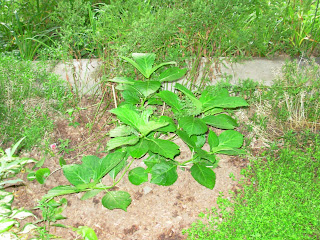
Not one blossom on any of these five plants!

A few of them have gotten overcrowded so that I will thin out around a few of the smaller ones.

But the two large ones are getting new homes,

as I make way for more edibles around the gardens.

Since several gardeners have asked why Hydrangeas don't always bloom, or don't come out the color you are looking for, I will look to my new, trusting reference book, "10,000 Garden Questions, Answered by 20 Experts", Fourth Edition, Marjorie J. Dietz, Editor, Originally compiled by F. F. Rockwell,1982, by The Literary Guild of America, Inc. (pages 371-374)
Hydrangeas do best in full sun, although they will stand slight shade. Oakleaf Hydrangea need partial shade.To make it bloom the following year, protect them from winter injury bu covering them in the fall with a bushel basket or leaves held in place with chicken wire or something similar. I do nothing for my copious blooming two in the front) Don't cut back the canes in spring any more than is necessary to remove injured tips. Too much shade, poor soil, overfertilization, improper pruning, and winter injury can be causes of non blooming plants. Flower buds are formed in the fall, and if the winter is severe they may be killed even though the plant is not injured. You should prune only in late July after blooming.
Hydrangeas can be propagated by cuttings.
Blue flowers can be induced by Potassium Alum (common alum)(pH 5.5); pink flowers by lime (pH 6.8 to 7.o). The required amount of lime should be deeply and thoroughly mixed with the soil. It is best to lift the plants in the fall, shake off as much soil as possible, and replant them in the specially prepared lime soil.

1 comment:
Good Morning
I wanted to add to my list of plants the deer have decided to devour. I was out in my garden yesterday and two of my beautiful sedum that I have been anxiously awaiting the blossoms were totally gone!!! Right down to the stalks. Then I walked further down and the oak leaf hydrangea was chewed off to the ground! I just put this plant in last year and it was taking off magnificently and now back to square one! Deer are so pretty from a distance but I'm beginning to hate them. I'm so frustrated. I keep reading online about deer resistant plants and can't believe they eat plants that they're not supposed to like. I have holly that is down to the stalks as well. I don't even want to talk about the 20 plants of hosta that disappeared. Can you imagine what it's going to be like when winter comes. You have to remember I'm surrounded by woods with plenty for them to eat but they think my property is a gourmet restaurant. Well I'm buying stock in Irish Spring and will be out tonight shaving it all around my plants.
I hope all the other gardeners in Marna's blog are having a better time contending with the plant predators!!
Regards,
Sheila
Post a Comment